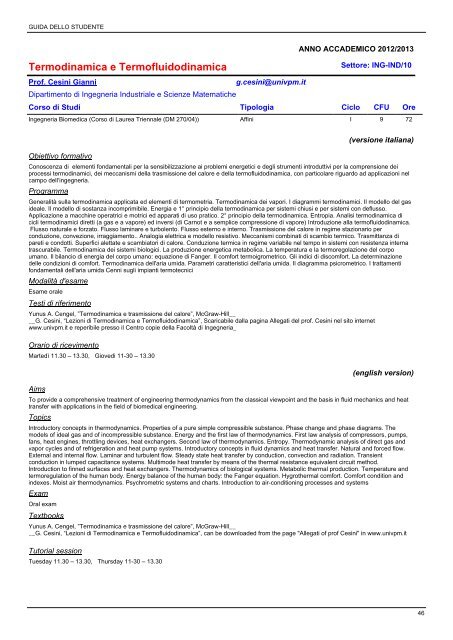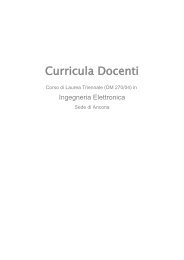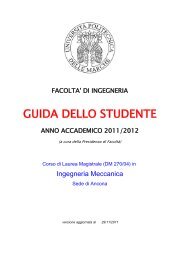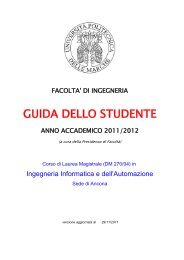270 - guida - Facoltà di Ingegneria
270 - guida - Facoltà di Ingegneria
270 - guida - Facoltà di Ingegneria
You also want an ePaper? Increase the reach of your titles
YUMPU automatically turns print PDFs into web optimized ePapers that Google loves.
GUIDA DELLO STUDENTE<br />
ANNO ACCADEMICO 2012/2013<br />
Termo<strong>di</strong>namica e Termofluido<strong>di</strong>namica<br />
Settore: ING-IND/10<br />
Prof. Cesini Gianni<br />
g.cesini@univpm.it<br />
Dipartimento <strong>di</strong> <strong>Ingegneria</strong> Industriale e Scienze Matematiche<br />
Corso <strong>di</strong> Stu<strong>di</strong> Tipologia Ciclo CFU Ore<br />
<strong>Ingegneria</strong> Biome<strong>di</strong>ca (Corso <strong>di</strong> Laurea Triennale (DM <strong>270</strong>/04)) Affini I 9 72<br />
Obiettivo formativo<br />
(versione italiana)<br />
Conoscenza <strong>di</strong> elementi fondamentali per la sensibilizzazione ai problemi energetici e degli strumenti introduttivi per la comprensione dei<br />
processi termo<strong>di</strong>namici, dei meccanismi della trasmissione del calore e della termofluido<strong>di</strong>namica, con particolare riguardo ad applicazioni nel<br />
campo dell’ingegneria.<br />
Programma<br />
Generalità sulla termo<strong>di</strong>namica applicata ed elementi <strong>di</strong> termometria. Termo<strong>di</strong>namica dei vapori. I <strong>di</strong>agrammi termo<strong>di</strong>namici. Il modello del gas<br />
ideale. Il modello <strong>di</strong> sostanza incomprimibile. Energia e 1° principio della termo<strong>di</strong>namica per sistemi chiusi e per sistemi con deflusso.<br />
Applicazione a macchine operatrici e motrici ed apparati <strong>di</strong> uso pratico. 2° principio della termo<strong>di</strong>namica. Entropia. Analisi termo<strong>di</strong>namica <strong>di</strong><br />
cicli termo<strong>di</strong>namici <strong>di</strong>retti (a gas e a vapore) ed inversi (<strong>di</strong> Carnot e a semplice compressione <strong>di</strong> vapore) Introduzione alla termofluido<strong>di</strong>namica.<br />
Flusso naturale e forzato. Flusso laminare e turbolento. Flusso esterno e interno. Trasmissione del calore in regime stazionario per<br />
conduzione, convezione, irraggiamento.. Analogia elettrica e modello resistivo. Meccanismi combinati <strong>di</strong> scambio termico. Trasmittanza <strong>di</strong><br />
pareti e condotti. Superfici alettate e scambiatori <strong>di</strong> calore. Conduzione termica in regime variabile nel tempo in sistemi con resistenza interna<br />
trascurabile. Termo<strong>di</strong>namica dei sistemi biologici. La produzione energetica metabolica. La temperatura e la termoregolazione del corpo<br />
umano. Il bilancio <strong>di</strong> energia del corpo umano: equazione <strong>di</strong> Fanger. Il comfort termoigrometrico. Gli in<strong>di</strong>ci <strong>di</strong> <strong>di</strong>scomfort. La determinazione<br />
delle con<strong>di</strong>zioni <strong>di</strong> comfort. Termo<strong>di</strong>namica dell'aria umida. Parametri caratteristici dell'aria umida. Il <strong>di</strong>agramma psicrometrico. I trattamenti<br />
fondamentali dell'aria umida Cenni sugli impianti termotecnici<br />
Modalità d'esame<br />
Esame orale<br />
Testi <strong>di</strong> riferimento<br />
Yunus A. Cengel, ”Termo<strong>di</strong>namica e trasmissione del calore”, McGraw-Hill__<br />
__G. Cesini, “Lezioni <strong>di</strong> Termo<strong>di</strong>namica e Termofluido<strong>di</strong>namica”, Scaricabile dalla pagina Allegati del prof. Cesini nel sito internet<br />
www.univpm.it e reperibile presso il Centro copie della Facoltà <strong>di</strong> <strong>Ingegneria</strong>_<br />
Orario <strong>di</strong> ricevimento<br />
Martedì 11.30 – 13.30, Giove<strong>di</strong> 11-30 – 13.30<br />
Aims<br />
(english version)<br />
To provide a comprehensive treatment of engineering thermodynamics from the classical viewpoint and the basis in fluid mechanics and heat<br />
transfer with applications in the field of biome<strong>di</strong>cal engineering.<br />
Topics<br />
Introductory concepts in thermodynamics. Properties of a pure simple compressible substance. Phase change and phase <strong>di</strong>agrams. The<br />
models of ideal gas and of incompressible substance. Energy and the first law of thermodynamics. First law analysis of compressors, pumps,<br />
fans, heat engines, throttling devices, heat exchangers. Second law of thermodynamics. Entropy. Thermodynamic analysis of <strong>di</strong>rect gas and<br />
vapor cycles and of refrigeration and heat pump systems. Introductory concepts in fluid dynamics and heat transfer. Natural and forced flow.<br />
External and internal flow. Laminar and turbulent flow. Steady state heat transfer by conduction, convection and ra<strong>di</strong>ation. Transient<br />
conduction in lumped capacitance systems. Multimode heat transfer by means of the thermal resistance equivalent circuit method.<br />
Introduction to finned surfaces and heat exchangers. Thermodynamics of biological systems. Metabolic thermal production. Temperature and<br />
termoregulation of the human body. Energy balance of the human body: the Fanger equation. Hygrothermal comfort. Comfort con<strong>di</strong>tion and<br />
indexes. Moist air thermodynamics. Psychrometric systems and charts. Introduction to air-con<strong>di</strong>tioning processes and systems<br />
Exam<br />
Oral exam<br />
Textbooks<br />
Yunus A. Cengel, ”Termo<strong>di</strong>namica e trasmissione del calore”, McGraw-Hill__<br />
__G. Cesini, “Lezioni <strong>di</strong> Termo<strong>di</strong>namica e Termofluido<strong>di</strong>namica”, can be downloaded from the page "Allegati of prof Cesini" in www.univpm.it<br />
Tutorial session<br />
Tuesday 11.30 – 13.30, Thursday 11-30 – 13.30<br />
46
















